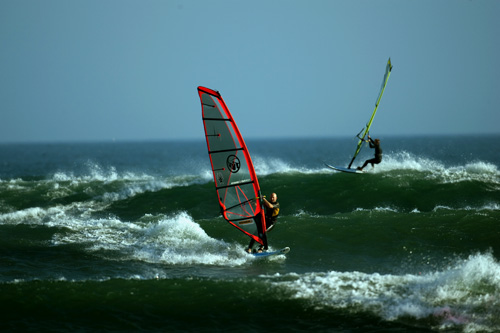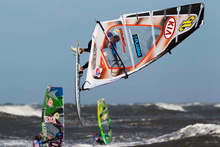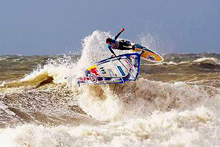
Jem Hall continues his fully frontside series as he gets you on the right wave in the right place at the right time – and in the right way. Alright?
A big well done to all of you who got out the back last time. Now you’re out there let’s look at what to do with all these waves coming your way and assist you in catching some sweet rides.
Surf check
First up, your best opportunity to spot a good wave is on your way out, so take advantage of that please. Now that you’re crossing the void and putting away those offshore sailing passes, you’ll be looking to catch the best waves – and using their most useful parts to give you speed, power, and of course some sweet turns. To enjoy the best part of wavesailing (i.e. riding) you’ll need and WANT to have excellent wave selection. This starts with becoming more of a waterperson, so yes, I am imploring you to get out there – shock-horror – on alternative watercraft. Didn’t you know everyone’s going surfing nowadays?
After a good long surf check you’re now in the best position to assess where the waves are forming and see your best route out. You can also observe and ask other riders.
Bus stop
From the beach and while sailing out, look for an area where the swells form up and start to get steeper with a view to breaking. This is called the ‘peak’. If you know where this is you’ll get the best waves and the most rides – and the more surfing you do the better your knowledge of this will be.
This area where all the fun is happening is the ‘bus stop’, because there’s nothing for a while and then three come along at once! And if you want your ticket to ride then you’d better be there and catching the right one to your destination.
You’ll need to wait at the bus stop to catch the right wave, so please have some patience. You may have to sail quite slowly up / across wind to let the wave come to you, and if you really mean business then you’ll prowl in this area until you spot your prey, and only then will you set off. Blasting into the beach with your arms apart and looking at the sail is not what wave catchers do. Waves do not move as fast as you, so keep calm, keep those eyes peeled, and remember you are now in the mindset of a young Jedi wavesailor.
Ahoy
Depending on water depth, tidal height, wave size, direction and speed, this peak will vary from being closer in to a lot further out. Once you’ve gone past the peak you’re ‘out the back’ and therefore in a safer area. This can sometimes be a long way out, and it can be quite eerie out there. The water’s flat, all is quiet … and then boom! Three big monsters are heading your way. So err on the side of caution and ensure that you’re outside the breaking zone when waiting. Slower waves are easy to catch but faster waves mean you’ll have to get motoring. This can catch people out, and as for all areas of wavesailing: good judgement comes from experience and experience is the result of poor judgement.




